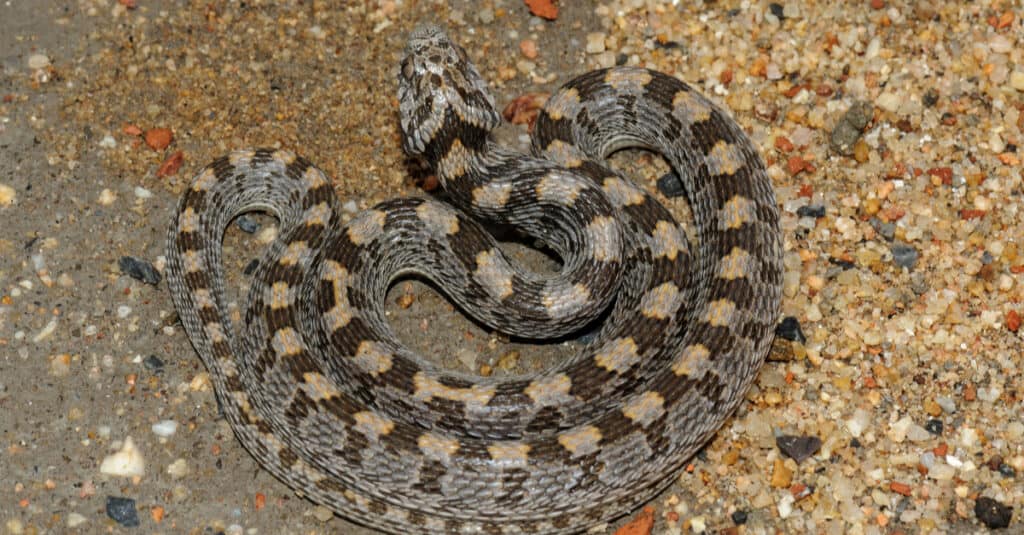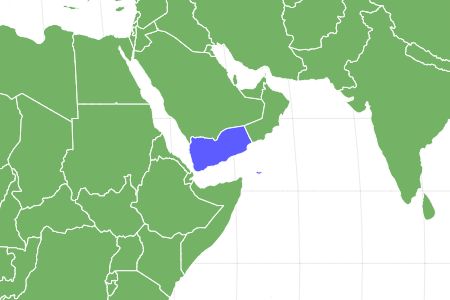Rhombic Egg-Eater Snake
Dasypeltis scabra
When birds aren't nesting, these snakes fast
Advertisement
Rhombic Egg-Eater Snake Scientific Classification
- Kingdom
- Animalia
- Phylum
- Chordata
- Class
- Reptilia
- Order
- Squamata
- Family
- Colubridae
- Genus
- Dasypeltis
- Scientific Name
- Dasypeltis scabra
Read our Complete Guide to Classification of Animals.
Rhombic Egg-Eater Snake Conservation Status
Rhombic Egg-Eater Snake Facts
- Name Of Young
- hatchlings or snakelets
- Fun Fact
- When birds aren't nesting, these snakes fast
- Estimated Population Size
- Unknown
- Most Distinctive Feature
- These snakes don't have teeth! Instead, they have ridges in their mouth and throat to hold eggs and projections in their spine to pierce the shell.
- Distinctive Feature
- Dark rhomboid-shaped spots on its back
- Other Name(s)
- Egg-eating snake or the common egg-eater
- Habitat
- These snakes thrive almost anywhere except in extreme deserts and in forests with closed canopies.
- Diet
- Carnivore
- Lifestyle
- Nocturnal
- Favorite Food
- Bird's eggs
- Common Name
- Rhombic Egg-Eater Snake
- Number Of Species
- 2
Rhombic Egg-Eater Snake Physical Characteristics
- Color
- Brown
- Yellow
- Tan
- Grey-Brown
- Lifespan
- 13 to 22 years
- Length
- 40 to 46 inches
- Venomous
- No
- Aggression
- Medium
View all of the Rhombic Egg-Eater Snake images!
It only eats birds’ eggs.
The rhombic egg-eater snake is well-named. It has rhomboid-shaped splotches on its back, and it eats eggs and only eggs. Indeed, it only eats birds’ eggs, not the eggs of other reptiles or amphibians. Its physiology has actually evolved to make the most of this specialized diet, and unlike a lot of snakes, it doesn’t have teeth lest it prematurely breaks its egg meal. What does it have instead? Read on to find out.
Four Amazing Facts
Here are four amazing facts about the rhombic egg-eater snake.
- It is nonvenomous, but a mimic of the venomous rhombic night adder and the saw-scaled viper.
- It’s also called the egg-eating snake or the common egg-eater.
- When threatened, the snake makes a hissing sound by rubbing its rough scales together. This is called saw-scaling.
- The snake’s sense of smell lets it know if an egg is rotten or if the baby inside is too well developed for it to easily digest.
Where To Find Rhombic Egg-Eater Snakes
Though the snake is listed as endemic to sub-Saharan Africa, it can also be found in Middle Eastern countries such as Yemen and Saudi Arabia. It thrives in a variety of different climates save extreme deserts and forests with closed canopies. Basically, it can be found nearly anywhere birds are found in its geographical range.
The population of these snakes is unknown and their conservation status is Least Concern.
Scientific Name
The scientific name of the rhombic egg-eater snake is Dasypeltis scabra. Dasypeltis comes from the Greek dasus and means “hairy” or “shaggy” and the Latin peltatus which means “a light shield.” Scabra means “scabby” or “rough” in Latin. This refers to the look of the snake’s keeled scales. There are two subspecies:
- Dasypeltis scabra loveridgei
- Dasypeltis scabra scabra
The Different Types of Rhombic Egg-Eater Snake
The rhombic egg-eater snake has two subspecies, D. scabra scabra, which is the nominate species and D. scabra loveridgei, which was named for Arthur Loveridge, a British herpetologist. The snake appears in different morphs. When it comes to snakes, morphs are those with genetic mutations that result in different colors and patterns in the same species. Egg-eater snakes that live in the same area most likely have the same coloration. This seems to be true not just of D. scabra but other snakes in the Dasypeltis genus.
Appearance and Description
The rhombic egg-eater snake is an animal of non-flashy appearance. The snake is not very large and grows to only about 3 to 4 feet. It comes in different morphs, and its ground color is neutral browns, grayish browns, or tans. There are darker, rhomboid-shaped spots on its back and brown spots along its sides. There’s also a V at the back of the snake’s head, and its belly is a shade of yellow and may or may not bear dark spots. It can usually be told from the venomous rhombic night adder by the shape of its pupils, which are most often vertical and cat-like. The night adder’s pupils are round.
It is difficult even for some experts to differentiate male and female snakes at a glance. A retailer can’t guarantee that a buyer will receive a male or female snake. Besides this, D. scabra doesn’t seem to breed in captivity.

Rhombic egg-eater snakes have dark, rhomboid-shaped spots
©Stephanie Periquet/Shutterstock.com
Rhombic Egg-Eater Snake Venom: How Dangerous Are They?
D. scabra is not venomous and is not dangerous to humans. Indeed, it doesn’t even have teeth to bite with. However, it is a nervous snake and will “hiss”, puff itself up, open its mouth wide and strike at a threat. This is sometimes enough for a potential predator to leave it alone.
Rhombic Egg-Eater Snake Behavior and Humans
The egg-eater snake is nocturnal, which means it hunts at night. Though it is most often found searching for prey or mates on the ground, it is a good climber. This skill allows it to find and raid the nests of birds whose eggs are the mainstay of its diet. The snake in turn is eaten by such predators as snake-eating eagles.
The way the snake eats is fascinating in and of itself. It only eats birds’ eggs, and when the birds are not nesting it simply fasts. Its jaws and throat can open even wider than those of most snakes to accommodate the eggs, which are held not by teeth but by ridges in the snake’s mouth. Once the egg is inside the snake, projections from its vertebrae pierce the shell, and the snake swallows the liquid insides. The crushed shell is simply spat out, immaculately, with little left of the contents clinging to it.
D. scabra males and females mate in the summer. The female lays between six and 25 eggs. They may either lay more than one clutch or even lay every egg in a different place. When the babies hatch they’re about 8.5 to 9.5 inches long.
Though the snake puts up an impressive threat display, it is harmless to humans. Some people actually keep these snakes as pets, though they are challenging to keep as they rarely grow large enough in captivity to be able to handle chicken eggs. However, if they can be coaxed into eating eggs the size of quail eggs they can be quite good pets. Some owners worry when their snake stops accepting eggs, but it is good to remember that the snake can fast for months when birds in its natural habitat aren’t breeding. The price of an egg-eating snake ranges from about $70 to $100. A potential owner should factor in the price of its enclosure, including substrate, heating and lighting and the price of food and veterinary care.
View all 114 animals that start with RRhombic Egg-Eater Snake FAQs (Frequently Asked Questions)
Dark rhomboid-shaped spots on its back
Rhombic egg-eater Snakes are not venomous.
How do rhombic egg-eater snakes hunt?
Rhombic snakes hunt like other snakes. Instead of warm-blooded mammals or other reptiles or amphibians, they use their tongues to pick up the scent of freshly laid eggs. Their sense of smell is so accurate that they can tell whether an egg is good to eat or not. Once they find an egg they swallow it whole, then use muscles in their throat and projections of their spinal column to pierce it. They then swallow the contents, and spit out the crushed shell.
Are rhombic egg-eater snakes aggressive?
These snakes are probably not aggressive but are said to be highly strung. They’ll make a threat display if they’re annoyed.
Where do rhombic egg-eater snakes live?
Rhombic egg-eater snakes live in sub-Saharan Africa but can also be found in the Middle East.
What do rhombic egg-eater snakes eat?
These snakes are unique in that they only eat bird eggs. Other snakes may eat these eggs along with other prey, but they are the only things D. scabra eats. It does not eat outside of egg-laying season.
What is a rhombic egg-eater snake?
The rhombic egg-eater snake is a colubrid snake native to Africa that only eats bird’s eggs. Its diet is so specialized that it basically has no teeth but ridges to hold the egg in its mouth and throat and projections in its spine to pierce the shell.
Are egg-eater snakes poisonous?
Egg-eater snakes are not poisonous.
Are egg-eating snakes good pets?
They can make good pets if the owner can find the right-sized bird egg for the snake to eat. Most of these snakes kept as pets don’t grow large enough to handle chicken eggs.
Thank you for reading! Have some feedback for us? Contact the AZ Animals editorial team.
Sources
- World Life Expectancy / Accessed April 20, 2022
- ITIS / Accessed April 20, 2022
- Wikipedia
- Science Direct / Accessed April 20, 2022
- iNaturalist / Accessed April 20, 2022
- Wikipedia / Accessed April 20, 2022
- Britannica / Accessed April 20, 2022
- Backwater Reptiles / Accessed April 20, 2022
- Snake Tracks / Accessed April 20, 2022
- Encyclopedia of Life / Accessed April 20, 2022


















